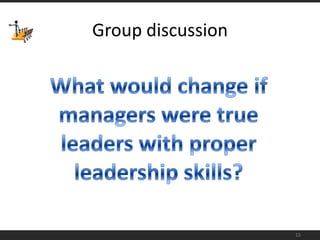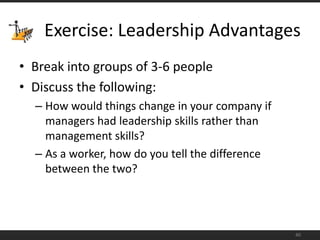Agile Leadership Is Overrated - Isnt It?
- 1. Agile Leadership is OverratedIsn’t It???Presented by Bob HartmanPresentation Copyright © 2009, Agile For All, LLC. All rights reserved.
- 2. Cell phones, pagers, PDA’s, etc. to silentIf you have a question, please ask it. Don’t wait! It is better to answer the question while we are still in the same area than to go back.We will take a break after about 90 minutes2Before We Start
- 4. 30+ years of software industry experienceCertified Scrum PractitionerBachelor and Masters degrees in Computer ScienceRoles included Tester, Developer, Dev Manager, QA Manager, Product Manager, Project Manager, VP…Started with agile in 19994Bob Hartman (Agile Bob)President Agile For Allbob.hartman@agileforall.com303-766-0917Blog: http://agilebob.com
- 5. Please introduce yourself including:NameCompany and roleAgile experience5Who are you?AboutMe
- 7. All definitions in this section are from:The American Heritage® Dictionary of the English Language, Fourth EditionCopyright © 2006 by Houghton Mifflin Company.Published by Houghton Mifflin Company. All rights reserved.7A word of thanks…
- 8. One who handles, controls, or directs, especially: One who directs a business or other enterprise. One who controls resources and expenditures, as of a household. One who is in charge of the training and performance of an athlete or a team. A student who is in charge of the equipment and records of a school or college team. One who is in charge of the business affairs of an entertainer. 8man·ag·er(mān'ĭ-jər) n.
- 9. The act, manner, or practice of managing; handling, supervision, or control: management of a crisis; management of factory workers.The person or persons who control or direct a business or other enterprise. Skill in managing; executive ability. 9man·age·ment (mān'ĭj-mənt) n.
- 10. Management – skill in managing, executive abilityManager – One who handles, controls or directs…Putting the two together means “handling”, “controlling” and “directing” are essential skills of managing, and indicators of executive abilityMost classically trained managers fit this mold10According to the definitions…
- 11. One that leads or guides. One who is in charge or in command of others. One who heads a political party or organization. One who has influence or power, especially of a political nature. A conductor, especially of orchestra, band, or choral group. The principal performer in an orchestral section or a group. 11lead·er (lē'dər) n.
- 12. The position or office of a leader: ascended to the leadership of the party.Capacity or ability to lead: showed strong leadership during her first term in office.A group of leaders: met with the leadership of the nation's top unions.Guidance; direction: The business prospered under the leadership of the new president.12lead·er·ship(lē'dər-shĭp') n.
- 13. 13A big problemSome people are appointed to be leaders, but have no leadership skills
- 14. An even bigger problem14The classic definition of management and manager are very different from leadership and leader. Why???
- 15. 15Group discussionWhat would change if managers were true leaders with proper leadership skills?
- 16. 16Questions to ponderAre you a project manager, or a project leader?Which do you want to be?
- 17. Herding cats!Otherwise known as Agile Leadership
- 18. Agile is all about…Working together to solve problemsNot using command and controlAllowing teams to self-directSo why do you need a project manager (remember the definition of manager is one who handles, controls, or directs)?The “unfortunate truth” is you don’t need this!18Agile – the problem child
- 19. 19Agile projects need LEADERS, not MANAGERS!Are you up to the challenge?
- 20. Who are Leaders?
- 21. Who leads or guides agile teams?Who else?Any others?MIND-BENDING THOUGHT ALERT!!!On an agile team, anyone can be a leader depending on the situation!21Putting this in an agile context
- 22. Only our entire thought process about how to help teams improve!We need to grow EVERYONE as leadersANDHelp them grow as FOLLOWERS as wellThe dynamics of communications change based on the situation and context22Does this change anything?
- 24. Managers often believe…being belligerent is necessary in order to get people to work hardinterrupting someone is acceptable in order to get to the point faster micromanaging is the only way to have teams do what is expected of themlistening to others is unimportant because their opinion isn’t going to change anythingAre these acceptable values???24The path to success
- 25. According to published studies, many managers who have the beliefs from the previous slide have been very successful!When asked why they were successful the managers often referenced those beliefs as key success factors.During 360 degree interviews, others interacting with those managers had a different story to tell…25The big surprise
- 26. 26Most of the managers in the studies have been successful IN SPITE OF those beliefs NOT BECAUSE OF THEM!
- 27. Break into small groupsDiscussHow do you find out how you are perceived by others?How do you let others know your perceptions of them?27Exercise: How do you get the truth?
- 28. Keys to Success
- 29. CompetenceHaving the ability to be successfulConnectionAdding value to your relationships with othersCharacterBeing an honest exampleCostSacrificing self for success of others29The 4 C’s of Leadership
- 30. Are you technically competent to do the jobDo others know you are competentAre you able to help others become more competentAre you able to look forward and see problems before they arise30Competence
- 31. Do you have enough relationships to leadDo you add value to relationships, or just suck value from themDo people know you careAre you quick to help, slow to blame31Connection
- 32. Do you hold yourself to high standardsAlways honest with reportsAlways acting with integrityHolding others accountable32Character
- 33. Are you willing to pay the priceWill you take the blame for the team in order to protect themDoes the “buck stop here” or “pass through here”Do you believe team success leads to personal success, or is it personal success in spite of the team33Cost
- 34. Break into 4 groupsFor your assigned “C” come up with an argument for why that particular characteristic is most importantCompetenceConnectionCharacterCost34Exercise: What is most important?
- 35. Servant leadership is an approach to leadership development, coined and defined by Robert Greenleaf and advanced by many other authors of books on leadership.Servant-leadership emphasizes the leader's role as steward of the resources (human, financial and otherwise) provided by the organization. It encourages leaders to serve others while staying focused on achieving results in line with the organization's values and integrity.35This is really Servant Leadership
- 36. 1. Listening – actively listening to what others are saying2. Empathy – feeling the pain and thrills of others3. Healing – helping others after they have been hurt4. Awareness – understanding the big picture5. Persuasion – persuading others to do what is right6. Conceptualization – helping the team understand7. Foresight – seeing problems before they arise8. Stewardship – helping the team use resources most effectively9. Commitment to growth of others – helping others improve10. Building community – helping the team become more than a group of individuals36Characteristics of servant leaders
- 37. We all fell for it!
- 38. We get it…Agile projects require leaders, not managersManaging and leading are differentManagement and leadership are differentWhat did we miss?38We didn’t fall for anything!
- 39. 39This isn’t only about agile projects!
- 40. Break into groups of 3-6 peopleDiscuss the following:How would things change in your company if managers had leadership skills rather than management skills?As a worker, how do you tell the difference between the two?40Exercise: Leadership Advantages
- 41. What will you do?Creating an action plan for success
- 42. For each of the 10 characteristics of a servant leader rate yourself on a 0-10 scale where 0 represents you don’t even know what it means to 10 means it is part of your DNA.42Exercise: Become a Great Leader
- 43. 43Exercise: Become a Great Leader
- 44. For the 3 characteristics which are your weakest develop an action plan for getting better.For each of the 3 include3 things to start doing3 things to stop doingIdentify a person you know who is strong in this area and what you can learn from themHow you will know you are making progress44Exercise: Become a Great Leader
- 45. 3 things to start doing3 things to stop doingPerson strong in this area:How I know I’m getting better:45Characteristic 1:
- 46. 3 things to start doing3 things to stop doingPerson strong in this area:How I know I’m getting better:46Characteristic 2:
- 47. 3 things to start doing3 things to stop doingPerson strong in this area:How I know I’m getting better:47Characteristic 3:
- 48. For the 3 characteristics which are your biggest strengths identify 3 tips you would give someone who struggles in that area. Be specific!48Exercise: Become a Great Leader
- 49. 3 tips for others49Characteristic 1:
- 50. 3 tips for others50Characteristic 2:
- 51. 3 tips for others51Characteristic 3:
- 52. Identify 2 people you want to help become great leaders so they can take over after you get promoted!Identify 2 specific actions you will take with each of them to help grow their skillsImagine you are not going to be able to help either of these people in the future, list 3 tips you would give to them to help them succeed.52Exercise: Become a Great Leader
- 53. 2 action items3 tips for them53Person 1:
- 54. 2 action items3 tips for them54Person 2:
- 55. Break into groups of 2-4 peopleIdentify a few areas where you have 1-2 people struggling and 1-2 people who are strong in that areaTalk about the potential action plans and the tips identified in early parts of the exercise.55Exercise: Become a Great Leader
- 56. Find a partner who can hold you accountable to your action planTell the people closest to you at both home and work what you are trying to improve so they don’t become worried about changes they seeAsk people who excel in your weak areas to mentor youKeep a journal of how you are doing56Going out on a limb
- 57. 57Great reading“What Got You Here Won’t Get You There” by Marshall Goldsmith“The 21 Irrefutable Laws of Leadership” by John Maxwell
- 58. A parting thought58Multiply your growth and effectiveness by developing leaders, not followers
- 59. Questions?
- 60. Thank you!Please fill out evaluation forms!



























































